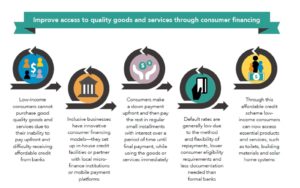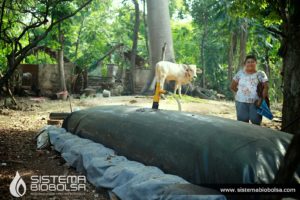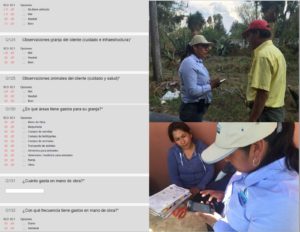
Search
Biogas system producer Sistema.bio hoped its planned asset-based financing program would invigorate product sales to farmers in Mexico. But when the social enterprise sought microfinance institutions to supply capital and manage lending for financing smallholder farmers, the proposed interest rates approached 120% and loan application processing time seemed lengthy.
Sistema.bio’s CEO Alexander Eaton took a deep breath and decided instead to build the company’s own loan underwriting and repayment program that could offer no interest loans that better matched its social mission. Finance Director Esther Altorfer said it’s a decision nobody regrets.
“We’ve managed to increase sales (and) we see it even now, as we are expanding, to be a key competitive advantage (compared) to other biogas companies,” said Altorfer. “Through the whole loan appraisal process we (also) get to know our customers much better.”
As more social enterprises selling products to base of pyramid consumers offer asset-based financing to drive purchases, these first-time lenders are getting a crash course in loan making and collections, especially when financing smallholder farmers. They are finding that technology – mobile apps, cloud databases and SMS messaging – is helping turn asset-based financing programs into a core competence.
Before outlining five key steps to creating such capacity in-house and the lessons companies have learned along the way, let’s answer a threshold question: Why offer such ancillary services in the first place?
Be it cash installment payments to purchase a waste-to-energy biodigester or pay-as-you-go mobile money transfers to buy a home solar power system, research and analysis by The World Bank Group and inclusive business consulting firm Hystra makes a compelling case for the value of consumer financing in developing countries:
“…The (consumer financing) model’s long-term significance is that companies can develop goods and services targeted at lower-income markets because consumer financing provides a way to alter the relationship between product cost and household disposable income,” according to a 2017 World Bank policy brief. “While other constraints to scaling up effective demand also need to be solved, tackling the ‘ability to pay bottleneck’ undoubtedly expands the reach into the BoP market.” (Read More)

Source: World Bank Group
Cleantech companies like Sistema.bio (focused on financing smallholder farmers) and solar power system distributor Ilumexico, along with WASH practitioner iDE (three TaroWorks customers who use our mobile offline CRM to help manage their business), are among the early adopters of consumer financing to drive product sales. They are also making good use of mobile, cloud-based technology to help oversee lending operations.
Social enterprises can either partner with a microfinance institution or bring the loan-making and managing process in-house. While both techniques have worked, Hystra recommends the latter as it believes developing staff lending skills and a supporting technology infrastructure in the organization “can provide value to customers” as well as “increase revenues and allow (an) organization to reach more clients.”
Ciprian Panturu – Digital Finance Expert at PHB Development and a consultant for the United Nations Capital Development Fund writes “…there are indeed opportunities for asset-based financing social enterprises to partner with (some) MFIs – mainly to leverage their field presence (e.g. cross-selling products and services), and/or to make use of their banking license.” But he also sees challenges when working with less technically sophisticated MFI lenders. Ciprian has witnessed a number of MFIs with inconsistent selling skills and lengthy loan turnaround times. In such cases, he concludes that partnering with an MFI might create unnecessary friction slowing down the roll-out.
“Moreover, as MFIs move into the digital space gradually, they end up with these unmanageable ‘cards castles’ of systems from various banking software providers (BSPs), that don’t talk to each other anymore…” Ciprian writes. “Usually, they end up managing one MIS for each module (i.e., the branches on the core banking system, the agency banking channel on the agency banking platform, the mobile banking channel on the mobile network operator’s interface, the automated credit scoring on its own platform, etc.) – so in the end, having a cross-institution analysis is mission impossible.”
Social enterprises looking to build their own, internal asset-based financing system have their work cut out for them, as well. They will need to:
Sistema.bio, which manufactures, sells, installs and services a hybrid reactor biodigester that transforms animal manure at small farms into biogas for clean cooking and a nutrient-rich organic fertilizer, began financing smallholder farmers in 2012. After a cash down payment, Sistema.bio installs the unit at the farm and then customers start reaping the benefits of the installed equipment (mostly savings). Customers however do not own the biodigester unit until completing 100% of subsequent installment payments. The goal is to incentivize small subsistence farmers to invest in an energy and fertilizer producing unit that will generate enough savings to repay its cost (around $800) within 18 to 24 months.

Biodigester in use on a farm. Source: Sistema.bio
When Sistema.bio decided not to pursue MFI funding due to high interest rates and lengthy loan turnaround times, it partnered instead with the crowdsourced funding platform Kiva, which to date has provided more than $590,000 in no-interest loans to over 600 farmers and lending guidance that Sistema.bio’s Altorfer said accommodated her company’s social mission. Sistema.bio was an early participant in a since completed pilot program Kiva established to support non-MFIs, or social enterprises whose business model is not based on credit, said Wesley Schrock, Kiva’s Portfolio Manager for Latin America. Kiva still provides such loans.
“Historically, (non-MFIs) have a much worse repayment rate than our MFIs,” said Schrock, who has worked with Sistema.bio to fine tune its lending operations. He believes it is an example of how the “professionalization of their credit process” can “help the organization expand and grow and access market rate capital.”
Altorfer, who came to the company with a background in finance and banking, said the organization’s learning curve for financing smallholder farmers has been steep but the benefits have also been substantial.
As the loan program grew, Sistema.bio faced the challenge of how to enhance and expand operations by developing a solid methodology to assess creditworthiness and using the results to make loan decisions in real-time – so as not to slow its product sales momentum. It also needed a way to monitor the status and health of its loan portfolio and make this information simultaneously available to multiple team members to quickly identify potentially delinquent borrowers.
Sistema.bio had already been using TaroWorks’ mobile data collection and analysis app and offline CRM capabilities, which are integrated into Salesforce.com’s CRM, to collect and analyze data in hopes of improving biodigester sales, product installation, maintenance and other field operations. To help strengthen its lending operations, Sistema.bio harnessed these same tools to:

Gathering credit scoring data in the field. Source: Sistema.bio
Sistema.bio has employed loan best practices, staff training and mobile technology to make significant progress financing smallholder farmers – from a time when they had no formal process for loan screening and origination. As a result, the percent of its loan portfolio that is on time increased from 64% to 73% within five weeks of several major process changes. Delinquency rates on new loans have dropped from at least 30% by the end of 2015 to zero as of Q3 2017.
With years of experience under its belt, Sistema.bio has teamed up with organizations dedicated to providing asset-based financing in Kenya and will conduct a trial of how an external partner might offer financing through a program similar to that now run by Sistema.bio – in hopes of complementing the in-house program and helping it scale.
Altorfer said Sistema.bio has learned a number of lessons that will help the company as it expands financing smallholder farmers in Mexico, Kenya and Nicaragua:
What does Altorfer see as some of Sistema.bio’s remaining challenges financing smallholder farmers?
“One of the challenges has been continuing to not operate as a traditional MFI but trying to really use our empathy-driven sales method to …. basically lend and provide financing to our clients by taking only the best practices…in the way that lending is traditionally made. We haven’t rejected any loan to date…We know that our digester is generating savings (for customers). We know the client has the capacity to pay us. We just have to gather the right data to determine what structure makes sense for them to repay us.”
Many TaroWorks customers previously used paper and spreadsheets to collect data, analyze metrics and run field operations. Let us show you how TaroWorks’ offline mobile field service app can help scale your business by digitizing sales and supply chain management, increasing agent network productivity and analyzing data in real-time for business insights.
POST TOPICS
Sign up to receive emails with TaroWorks news, industry trends and best practices.
TaroWorks, a Grameen Foundation company.
Site by V+V